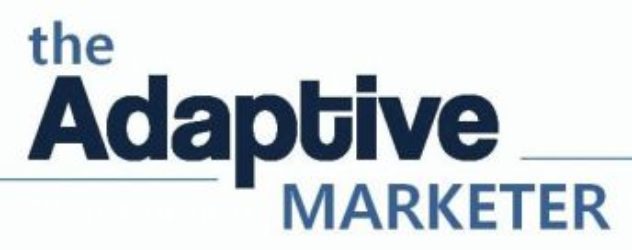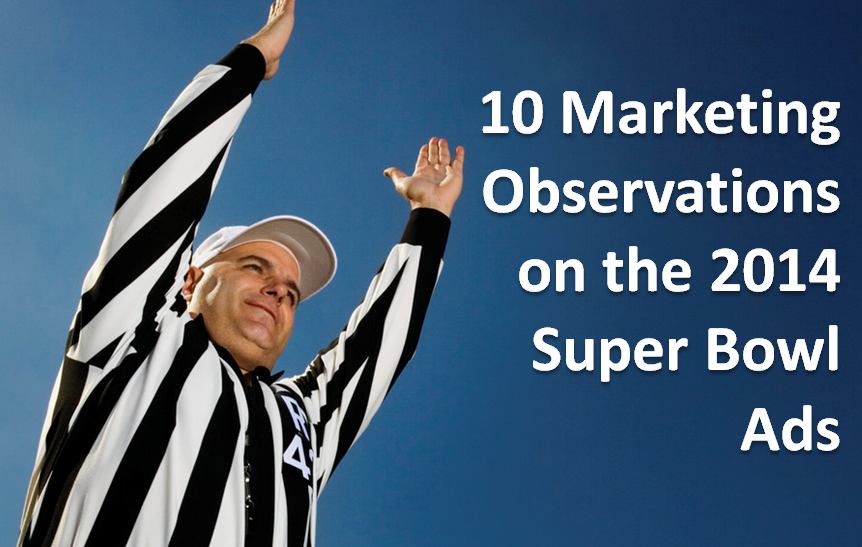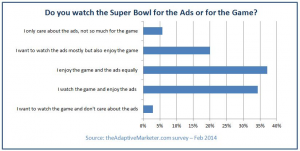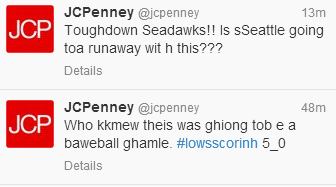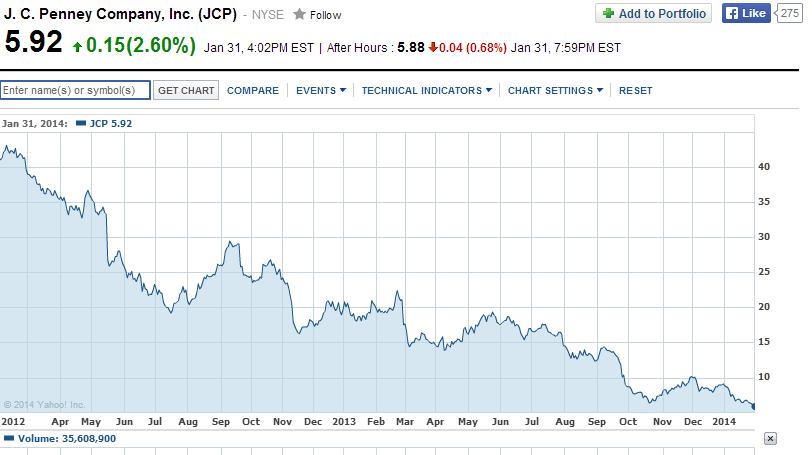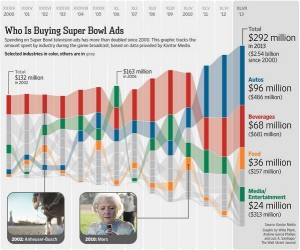Surprisingly, the Super Bowl is not the most-viewed sports event in the world. At some 150 million viewers, it represents a fraction of the estimated 720 million viewers for the FIFA World Cup final. Despite this fact, it remains the largest advertising event in the world.
According to an informal survey we ran last week, over 60% of Super Bowl viewers claimed to watch the game just as much, or more for the ads. Welcome to the Ad Bowl.
By now there are probably a couple dozen lists of top Super Bowl ads, and everyone has begun expressing their own opinions. In this post, I will share my observations on the marketing strategies of the brands and the effectiveness of their ads, as well as general advertising trends. Please add your observations in the comments section.
1. Advertisers are focused on winning a popularity contest.
Most of these lists rank the ads based on their entertainment value, cuteness or personal identification with the brand. Advertisers are so focused on the popularity aspect that they are losing sight of the fact that the only purpose of an investment in advertisement is to compel viewers to take actions, grow interest in a brand and predispose customers to buy: to drive sales.
Funny ads can get people talking about the brand, which can help brands that are looking for awareness. Go Daddy is a prime example of this fact (read the sister post on Super Bowl Ads: Good Investment or Giant Waste of Money?. However, only a select few of the brands who advertised this year need awareness. Most consumers already have an awareness of the brands advertised in the Super Bowl. Thus, the bar is set rather high for marketers, as buzz about the brands doesn’t always result in sales.
Audi’s ‘Doberhuahua’ was funny and visually appealing, but lacked a clear connection between the dogs and the Audi A3. Somehow ‘luxury without compromise’ is connected with the bad compromise that represents the doberhuahua breed, though I doubt this concept will result in an increase in car sales.
Honda’s ad showed the Muppets on their new Highlander SUV. The ad was crazy, drawing too much of the viewer’s attention to the puppets and not enough to the actual product. The ad failed to make a connection between the muppets and the car, and seriously lacked any visual or text message on why anyone should think of purchasing the Highlander.
2. Social media has peaked – or matured.
Last year, it seemed like every Super Bowl ad included a link to the brand’s Facebook page. Without a clear social media strategy, doing so is usually a idea. This year, not one brand promoted a Facebook URL in their ads. MarketingLand’s “#Hashtag Bowl” showed that while 57% of ads displayed tags, only 9% displayed a Facebook tag, and none of the ads mentioned Pinterest, Google+ or Instagram .
Although these statistics may sound surprising, I don’t interpret them to be a sign that social media is passé. Quite the contrary, I hope this
points to marketers becoming more mature in their use of social media, instead of jumping on it solely because every other marketer is doing so. During the Super Bowl, there was considerable activity on Twitter, which brings us to the next point.
3. Real-time marketing – did it work?
Last year Oreo established a new bar for real-time marketing by reacting quickly to the blackout and running an effective campaign.
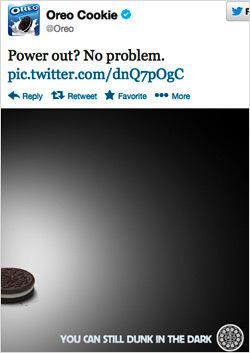
This year, many brands established social media operation centers ready to do the same. The results, however, were disappointing. It seemed brands were more interested in talking to each other than in interacting with consumers.
The biggest flop of the game was JC Penney, who started seemingly tweeting drunk. Later in the game, the brand tried to explain it as ‘tweeting with mittens’, complete with a hashtag.
They got the attention, probably subscribing to the idea that any PR is good PR. This is a flawed perspective. I believe JC Penney simply made a fool of themselves. It was clearly a marketing gimmick, and it backfired. Their social media strategy is unlikely to help JC Penney in their dire situation.
4. Pre and post-Super Bowl marketing heats up.
This year, many brands provided sneak-peeks at their ads and some proactively marketed them. The ad Puppy Love, for example, was viewed 36.2 million times before the game even aired (source). Based on this year’s results, I expect this trend to grow over the next few years.
Esurance was masterful in the execution of their ad, which ran just after the game. First, the company saved a lot of money, which they offered back to viewers who tweeted their hashtag #EsuranceSave30 . The result was over 1.4 million tweets, according to Hashtags.org.
Another reason the Esurance ad showed a best practice is that the hashtag was on the screen for the entire ad. In comparison, many other ads showed the brand itself on the screen only for the last few seconds of their ads, making it easy to miss the brand that is running the ad.
5. Emotional Marketing
A couple of brands aimed to make an emotional connection with viewers through their ads. Budweiser’s ad A Hero’s Welcome was a good example. Chevy also took this approach by promoting support for World Cancer Day. In both cases, some viewers found the ads to be insincere, a marketing ploy to take advantage of real issues.
TurboTax also went for emotions, but I am afraid the connection between prom and Taxes is a weak one. Perhaps the best example of a brand with seemingly insincere motives is the play for world peace employed by Axe. The message was not consistent with the brand image that Axe has been promoting for years.
Although there were some poor examples of emotional marketing throughout the Super Bowl, Coca Cola successfully targeted the emotions of consumers with their ad, America the Beautiful. Coke has been associating itself with happiness and key human values for many decades, so it is not only consistent, but the ad also reinforces the brand’s image.
Honda also did a good job appealing to emotions. Their ad had a different tone from the rest, which helped it stand out. The message was about the importance of building safer cars. It is about people, and it sounded sincere. Their claim of building the safest cars on the road connected the emotions with the brand. I believe this is the kind of ad that may not win awards or popularity contests, but can make a long-lasting positive impression on consumers and potentially increase sales.
6. Repositioning Brands
The Super Bowl is a great opportunity to reposition a brand and launch products. The best example lies in Apple’s 1984 ad for the original Mac, considered by many to be the best ad ever.
This year, it was interesting to see Kia trying to move up in the market with the K900, a car that sells for $60,000. It is an uphill battle, especially for a brand that currently sells cars at an average price of $17,500. Selling a Kia for $60,000 proves challenging when companies with an existing premium brand position, like Jaguar for example, sells a luxury car for $47,000.
Furthermore, Jaguar’s strategy was interesting. They appealed to the mischievous side in all of us with their villain theme, ‘it’s going to be bad’. The car promoted during the game, the F-Type, also sells in the $60,000 range.
Probably the most commented car ad was Maserati’s. The company attempted to build their momentum towards becoming a mainstream luxury brand. According to KBB, searches for Maserati went up 700% on kbb.com after the ad aired. I think the brand missed a big opportunity in repositioning itself due to the fact that many viewers do not know the model Maserati is promoting. The Ghibli is a ‘mere’ $67,000, just a few grand more than a Kia.
7. Taking advantage of American pride
A number of ads appealed to nationalist sentiment. WeatherTech, a company that has traditionally made large investments in magazine ads, focused their ad on the concept of ‘made in the US’. This is consistent with the positioning they have been using for years.
Chrysler tried to build on their success from last year (‘imported from Detroit’) with an ad that stated ‘let Germany build your car, Switzerland build your watch, we will build your car’. The execution and choice of using Bob Dylan as a spokesperson was controversial for some viewer.
8 Winners: Differentiation and Calls to Action drive Effectiveness
Surprisingly, very few advertisers followed marketing basics of providing clear differentiation of the product to persuade, and a clear call to action. U2 ran a promotion that sounded like a winner: a good cause (fighting AIDS), awesome music and the clearest call to action. Download the song, and Bank of America will donate $1. Even though the total donation was over $3 million (according to this source) , a tad under the cost of airing the promotion, the ad is a success in that it offers a win-win-win.
T-Mobile ran multiple hit ads. Teebow’s self-deprecating humor was very well aligned with T-Mobile’s value proposition, ‘we don’t need a contract’. It spoke directly to a pain cell phone users suffer and finally gave Teebow a Super bowl appearance that was much more successful than that of Peyton Manning.
After last’s year’s success, Volkswagen had another good ad in 2013 that promoted the durability of Volkswagen cars with humor. I think the ad worked even with its well played subtle adult humor displayed in the bathroom scene, and despite consumers‘ tweets pointing that the ad showed no female engineers.
9. Less sexist ads
This year, Go Daddy pursued a more mature approach by appealing to entrepreneurs and their aspirations for growth, rather than using skin to call attention to the brand. I applaud them for that.
The event was not totally clean, however. There was the somewhat controversial Butterfinger ad and H&M ad, which used David Beckham’s nakedness to sell clothes. Done tastefully, the ad was for underwear, a category that likely represents less than 1% of the retailer’s sales. I don’t expect complaints to the European clothing retailer about the company’s ads objectifying men.
10. Some Ads Flopped Despite Their Popularity
Aside from JC Penney’s Twitter disaster, perhaps the worst ad came from RadioShack. The ad was memorable, popular and fun. But did it make viewers want to go to the store? That’s the main measure of success, and I think they failed.
While I applaud the company’s self-deprecating humor, it was risky to reinforce the association of the company with old times. The ad did not provide a single reason to visit the stores, aside from them being renovated. The ad did not answer the question, ‘why should I go to a Radio Shack instead of Best Buy?’ The ad concept also completely ignored the online sales channel.
RadioShack took the opportunity to launch a new ‘brand position’ according to the company . The new position is reinforced via a tag-line on the landing page linked from the ad, ‘Do it. Together’, which belongs in the hall of shame for the worst tag lines in history. It is too similar to Nike’s tag line, ‘Just do it’, and Home Depot’s, ‘You can do it. We can help.’. There is no relation to the category in which the company plays and it does not provide a hint of a value proposition.
Many brands failed to connect the visuals of their ads with the brand and what makes them unique. Others spent too much time on the build-up rather than on persuasion. A good example of this is the Goldiebox ad. If you missed the last two seconds of the ad, you could not guess what product or brand it was about. From what I saw on twitter, it seems only the consumers who were already familiar with the brand understood the ad.
Last, here is some interesting information from the Wall Street Journal on how advertisers for the super bowl have changed over the past few years:
So, these are my observations for the Super Bowl commercials. Where do you agree or disagree? What did I miss? I look forward to your comments.
